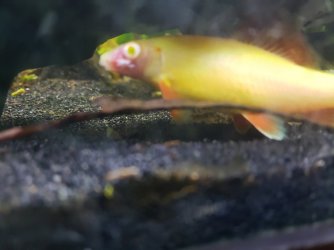It looks like a bacterial or fungal infection, hard to tell due to picture.
Salt might treat it. See following for dose rates. Flubendazole won't do anything. Melafix might help but salt is probably the better option, or look for a broad spectrum fish medication that treats bacterial, fungal and protozoan infections.
Increase aeration/ surface turbulence when using salt or medications because they reduce the oxygen levels in the water.
---------------------
SALT
For some fish diseases you can use salt (sodium chloride) to treat the ailment rather than using a chemical based medication. Salt is relatively safe and is regularly used in the aquaculture industry to treat food fish for diseases. Salt has been successfully used to treat minor fungal and bacterial infections, as well as a number of external protozoan infections. Salt alone will not treat whitespot (Ichthyophthirius) or Velvet (Oodinium) but will treat most other types of protozoan infections in freshwater fishes.
You can add rock salt (often sold as aquarium salt) or swimming pool salt to the aquarium at the dose rate of 1 heaped tablespoon per 20 litres of water. If there is no improvement after 48 hours you can double that dose rate so there is 2 heaped tablespoons of salt per 20 litres.
If you only have livebearers (guppies, platies, swordtails, mollies), goldfish or rainbowfish in the tank you can double that dose rate, so you would add 2 heaped tablespoons per 20 litres and if there is no improvement after 48 hours, then increase it so there is a total of 4 heaped tablespoons of salt per 20 litres.
Keep the salt level like this for at least 2 weeks but no longer than 4 weeks otherwise kidney damage can occur. Kidney damage is more likely to occur in fish from soft water (tetras, Corydoras, angelfish, Bettas & gouramis, loaches) that are exposed to high levels of salt for an extended period of time, and is not an issue with livebearers, rainbowfish or other salt tolerant species.
The salt will not affect the beneficial filter bacteria but the higher dose rate (4 heaped tablespoons per 20 litres) will affect some plants and some snails. The lower dose rate (1-2 heaped tablespoons per 20 litres) will not affect fish, plants, shrimp or snails.
After you use salt and the fish have recovered, you do a 10% water change each day for a week using only fresh water that has been dechlorinated. Then do a 20% water change each day for a week. Then you can do bigger water changes after that. This dilutes the salt out of the tank slowly so it doesn't harm the fish.
If you do water changes while using salt, you need to treat the new water with salt before adding it to the tank. This will keep the salt level stable in the tank and minimise stress on the fish.


